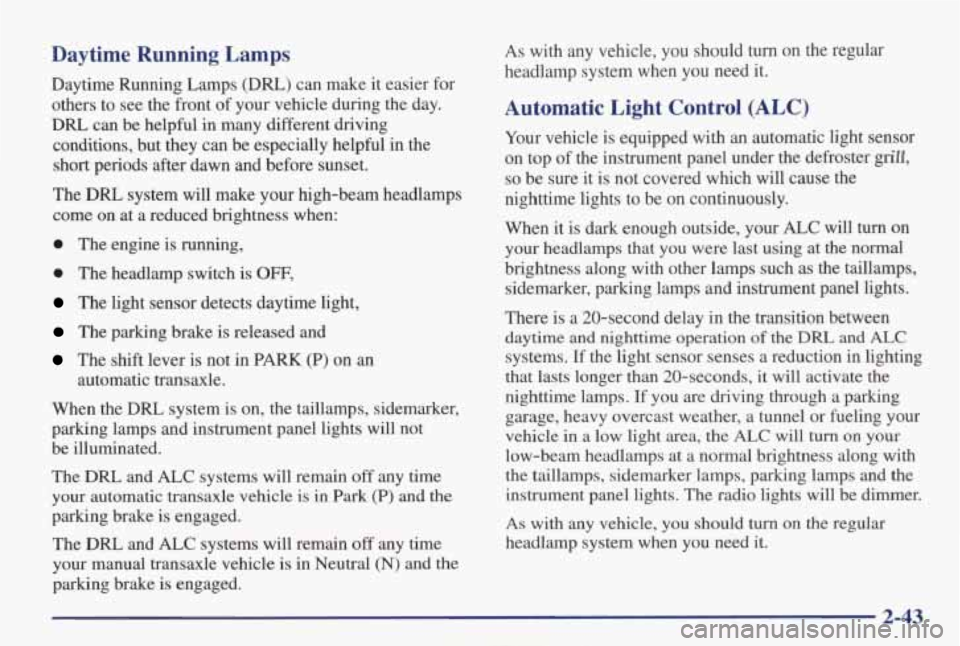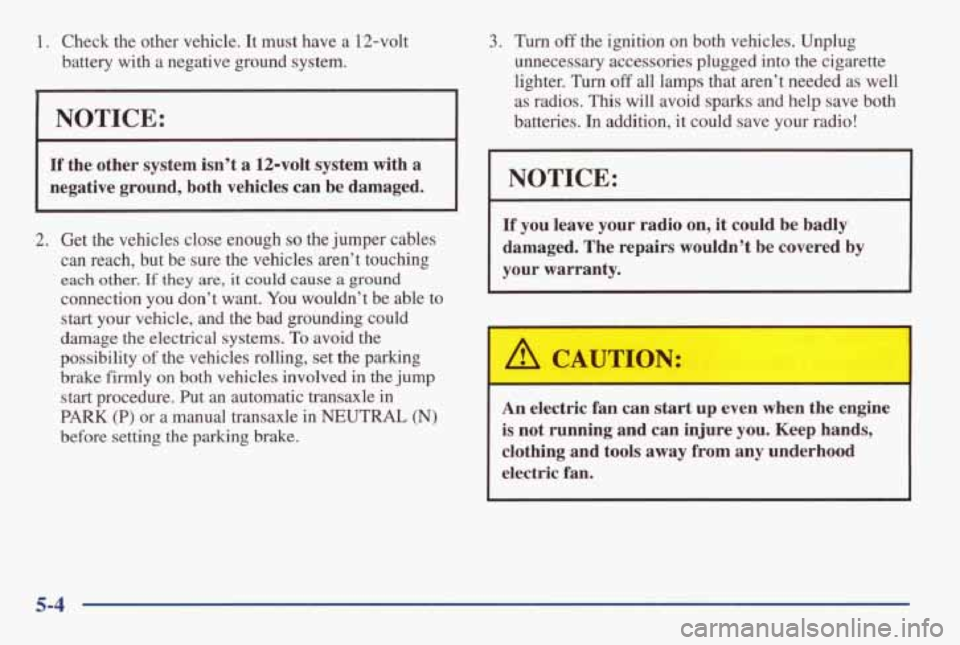manual radio set PONTIAC GRAND AM 1998 Owners Manual
[x] Cancel search | Manufacturer: PONTIAC, Model Year: 1998, Model line: GRAND AM, Model: PONTIAC GRAND AM 1998Pages: 370, PDF Size: 16.11 MB
Page 104 of 370

Daytime Running Lamps
Daytime Running Lamps (Dm) can make it easier for
others to see the front of your vehicle during the day.
DRL can be helpful in many different driving
conditions, but they can be especially helpful in the short periods after dawn and before sunset.
The
DRL system will make your high-beam headlamps
come on at a reduced brightness when:
0 The engine is running,
0 The headlamp switch is OFF,
The light sensor detects daytime light,
The parking brake is released and
The shift lever is not in PARK (P) on an
When the DRL system is on, the taillamps, sidemarker,
parking lamps and instrument panel lights will not
be illuminated. automatic transaxle.
The
DIU and ALC systems will remain off any time
your automatic transaxle vehicle is
in Park (P) and the
parking brake is engaged.
The
DFU and ALC systems will remain off any time
your manual transaxle vehicle is in Neutral
(N) and the
parking brake is engaged.
As with any vehicle, you should turn on the regular
headlamp system when you need it.
Automatic Light Control (ALC)
Your vehicle is equipped with an automatic light sensor
on top of the instrument panel under the defroster
grin,
so be sure it is not covered which will cause the
nighttime lights to be on continuously.
When it is dark enough outside,
your ALC will turn on
your headlamps that you were last using at the normal
brightness along with other lamps such as the taillamps,
sidemarker, parking lamps and instrument panel lights.
There is a 20-second delay in the transition between
daytime and nighttime operation
of the DRL and LC
systems. If the light sensor senses a reduction in lighting
that lasts longer than 20-seconds, it will activate the
nighttime lamps. If you are driving through a parking
garage, heavy overcast weather, a tunnel or fueling your
vehicle in a low light area, the
ALC will turn on your
low-beam headlamps at a normal brightness along with
the taillamps, sidemarker lamps, parking lamps and the
instrument panel lights. The radio lights will be dimmer.
As with any vehicle, you should turn on the regular
headlamp system when you need
it.
Page 203 of 370

i . Check the other vehicle. It must have a 12-volt
battery with a negative ground system.
I NOTICE:
If the other system isn’t a 12-volt system with a
negative ground, both vehicles can be damaged.
2. Get the vehicles close enough so the jumper cables
can reach, but be sure the vehicles aren’t touching
each other. If they are, it could cause a ground
connection you don’t want.
You wouldn’t be able to
start your vehicle, and the bad grounding could
damage the electrical systems.
To avoid the
possibility
of the vehicles rolling, set the parking
brake firmly
on both vehicles involved in the jump
start procedure.
Put an automatic transaxle in
PARK (P) or a manual transaxle in NEUTRAL (N)
before setting the parking brake.
3. Turn off the ignition on both vehicles. Unplug
unnecessary accessories plugged into the cigarette
lighter.
Turn off all lamps that aren’t needed as well
as radios. This will avoid sparks and help save both
batteries.
In addition, it could save your radio!
I NOTICE:
If you leave your radio on, it could be badly
damaged. The repairs wouldn’t be covered by
your warranty.
A CAUTION:
An electric fan can start up even when the engine
is not running and can injure you. Keep hands,
clothing and tools away from any underhood
electric fan.
1
5-4
Page 365 of 370

Radio Reception .............................. 3-23
Radios
........................................ 3-7
Rain. Driving In
................................ 4- 18
Reading
Lamps ........................... 2-45. 2-46
Door Security Locks
........................... 2-6
Outside Seat Position .......................... 1-28
Safety Belt
Comfort Guides ..................... 1-31
Seatpassengers
.............................. l-28
Window Defogger ............................. 3-5
RearSeatCupholder
............................ 2-49
RearTowing
................................... 5-11
RearviewMirror
................................ 2-47
Inside Daymight
............................. 2-47
Reclining Front Seatbacks
......................... 1-4
Recommended
Fluids and Lubricants ............... 7-36
Recreational Vehicle Towing ...................... 4-30
Refrigerants.
Air Conditioning .................... 6-65
Fuel
Door Release ............................. 6-6
Trunk Release ................................ 2- 11
Remote Cassette Tape Player
...................... 3- 18
Rear
Remote Replacement Bulbs
...................................... 6-64
Parts
....................................... 6-66
Wheel
...................................... 6-48
Replacing Safety Belts
........................... 1-52
Reporting Safety Defects
......................... 8-10
Checking
.................................... 1-52
Child
....................................... 1-38
Head
........................................ 1-5
Replacing
Parts After a Crash ................... 1-52
System Check
................................ 7-31
Restraints Reverse. Automatic Transaxle
..................... 2-22
Reverse. Manual Transaxle
....................... 2-26
Right
Front Passenger Position .................... 1-21
Roadside Assistance
.............................. 8-6
Roadside Assistance. Canadian ..................... 8-8
Rocking
Your Vehicle
Rotation. Tires
.....
safety Belt Extender
Safety Belts
.......
Adults ..........
Care ...........
~ ~~~~
........................... 5-34
........................... 6-43
............................ 1-52
............................. l-7
............................ 1-13
. . 6-53 .....................
Center Rear Passenger Position .................. 1-33
Children
.................................... 1-35
DriverPosition
............................... 1-13
Extender
.................................... 1-52
How to Wear Properly ......................... 1-13
IncorrectUsage
..... 1-16,l-17, 1-18, 1-19,l-50, 1-51
Larger Children
.............................. 1-49
Passenger Position
............................ 1-21
Questions and
Answers ........................ 1-12
Rear Comfort Guides
.......................... 1-31
Rear Seat Outside Passenger Positions
............ 1-28
Rear Seat Passengers
.......................... 1-28
Reminder Light
.......................... 1-8, 2-57
Replacing After a Crash ........................ 1-52
Right Front Passenger Position
.................. 1-21
Shoulder Belt Height Adjuster
................... 1-15
Smaller Children and Babies
.................... 1-35
Use During Pregnancy
......................... 1-20
Why They Work
............................... 1-9
LapBelt
.................................... l-34
Lap-Shoulder ........................... 1-15,
1-28
9-8